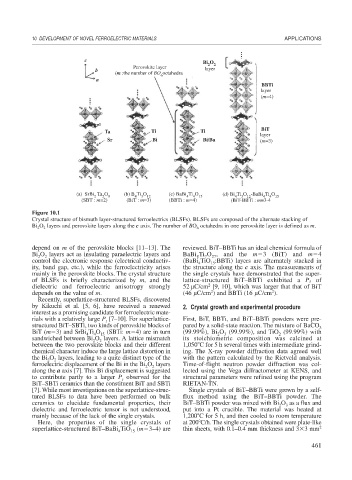Page 489 - Book Hosokawa Nanoparticle Technology Handbook
P. 489
10 DEVELOPMENT OF NOVEL FERROELECTRIC MATERIALS APPLICATIONS
c Bi O
Perovskite layer 2 2
b layer
(m :the number of BO octahedra
6
a
BBTi
layer
(m=4)
BiT
Ta Ti Ti
layer
Sr Bi Bi/Ba (m=3)
(a) SrBi Ta O (b) B Ti O (c) BaBi Ti O (d) Bi Ti O -BaBi Ti O
3 12
4 15
2 9
4
4
4
2
3 12
4 15
4
(SBT : m=2) (BiT : m=3) (BBTi : m=4) (BiT-BBTi : m=3-4
Figure 10.1
Crystal structure of bismuth layer-structured ferroelectrics (BLSFs). BLSFs are composed of the alternate stacking of
Bi O layers and perovskite layers along the c axis. The number of BO octahedra in one perovskite layer is defined as m.
2
6
2
depend on m of the perovskite blocks [11–13]. The reviewed. BiT–BBTi has an ideal chemical formula of
Bi O layers act as insulating paraelectric layers and BaBi Ti O , and the m 3 (BiT) and m 4
8
7
2
2
27
control the electronic response (electrical conductiv- (BaBi TiO :BBTi) layers are alternately stacked in
4
15
ity, band gap, etc.), while the ferroelectricity arises the structure along the c axis. The measurements of
mainly in the perovskite blocks. The crystal structure the single crystals have demonstrated that the super-
of BLSFs is briefly characterized by m, and the lattice-structured BiT–BBTi exhibited a Ps of
dielectric and ferroelectric anisotropy strongly 52 C/cm [9, 10], which was larger that that of BiT
2
depends on the value of m. (46 C/cm ) and BBTi (16 C/cm ).
2
2
Recently, superlattice-structured BLSFs, discovered
by Kikuchi et al. [5, 6], have received a renewed 2. Crystal growth and experimental procedure
interest as a promising candidate for ferroelectric mate-
rials with a relatively large P [7–10]. For superlattice- First, BiT, BBTi, and BiT–BBTi powders were pre-
r
structured BiT–SBTi, two kinds of perovskite blocks of pared by a solid-state reaction. The mixture of BaCO 3
BiT (m 3) and SrBi Ti O (SBTi: m 4) are in turn (99.99%), Bi O (99.99%), and TiO (99.99%) with
2
3
2
15
4
4
sandwiched between Bi O layers. A lattice mismatch its stoichiometric composition was calcined at
2
2
between the two perovskite blocks and their different 1,050 C for 5 h several times with intermediate grind-
chemical character induce the large lattice distortion in ing. The X-ray powder diffraction data agreed well
the Bi O layers, leading to a quite distinct type of the with the pattern calculated by the Rietveld analysis.
2
2
ferroelectric displacement of the Bi in the Bi O layers Time-of-flight neutron powder diffraction was col-
2
2
along the a axis [7]. This Bi displacement is suggested lected using the Vega diffractometer at KENS, and
to contribute partly to a larger P observed for the structural parameters were refined using the program
r
BiT–SBTi ceramics than the constituent BiT and SBTi RIETAN-TN.
[7]. While most investigations on the superlattice-struc- Single crystals of BiT–BBTi were grown by a self-
tured BLSFs to data have been performed on bulk flux method using the BiT–BBTi powder. The
ceramics to elucidate fundamental properties, their BiT–BBTi powder was mixed with Bi O as a flux and
3
2
dielectric and ferroelectric tensor is not understood, put into a Pt crucible. The material was heated at
mainly because of the lack of the single crystals. 1,200 C for 5 h, and then cooled to room temperature
Here, the properties of the single crystals of at 200 C/h. The single crystals obtained were plate-like
superlattice-structured BiT–BaBi TiO (m 3–4) are thin sheets, with 0.1–0.4 mm thickness and 3 3 mm 2
4 15
461

